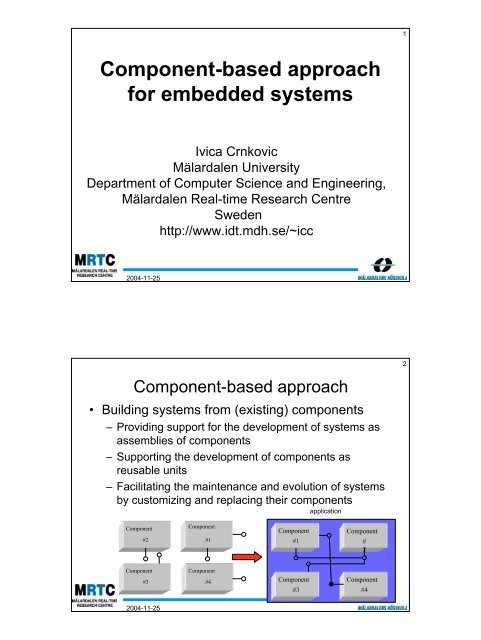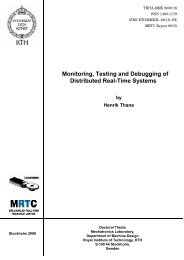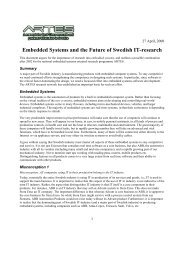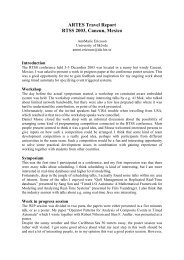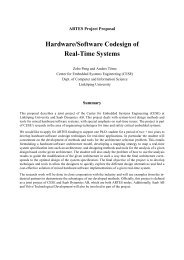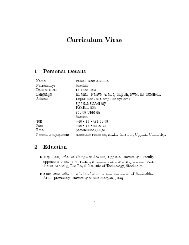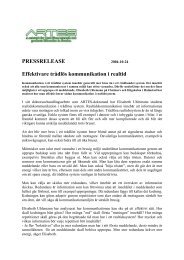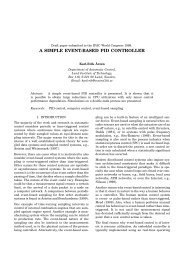Component-based approach for embedded systems - Artes
Component-based approach for embedded systems - Artes
Component-based approach for embedded systems - Artes
You also want an ePaper? Increase the reach of your titles
YUMPU automatically turns print PDFs into web optimized ePapers that Google loves.
1<br />
<strong>Component</strong>-<strong>based</strong> <strong>approach</strong><br />
<strong>for</strong> <strong>embedded</strong> <strong>systems</strong><br />
Ivica Crnkovic<br />
Mälardalen University<br />
Department of Computer Science and Engineering,<br />
Mälardalen Real-time Research Centre<br />
Sweden<br />
http://www.idt.mdh.se/~icc<br />
2004-11-25<br />
2<br />
<strong>Component</strong>-<strong>based</strong> <strong>approach</strong><br />
• Building <strong>systems</strong> from (existing) components<br />
– Providing support <strong>for</strong> the development of <strong>systems</strong> as<br />
assemblies of components<br />
– Supporting the development of components as<br />
reusable units<br />
– Facilitating the maintenance and evolution of <strong>systems</strong><br />
by customizing and replacing their components<br />
application<br />
<strong>Component</strong><br />
#2<br />
<strong>Component</strong><br />
#1<br />
<strong>Component</strong><br />
#1<br />
<strong>Component</strong><br />
#<br />
2<br />
<strong>Component</strong><br />
#3<br />
<strong>Component</strong><br />
#4<br />
<strong>Component</strong><br />
#3<br />
<strong>Component</strong><br />
#4<br />
2004-11-25
3<br />
Implications<br />
• <strong>Component</strong> development is separated from system<br />
development process<br />
– Less programming ef<strong>for</strong>ts to build <strong>systems</strong><br />
– System verification and validation more difficult and more<br />
important<br />
– Different requirements management<br />
Requirements<br />
Specification<br />
Application<br />
development<br />
Find & Select<br />
Design<br />
Test<br />
Implementation<br />
Adapt<br />
<strong>Component</strong><br />
development<br />
Deploy<br />
Test<br />
Operation &<br />
Maintenance<br />
2004-11-25<br />
4<br />
Describing a <strong>Component</strong><br />
• To be able to describe a component completely the component<br />
should consist of the following elements:<br />
– A set of interfaces provided to, or required from the environment.<br />
– An executable code, which can be coupled to the code of other<br />
components via interfaces.<br />
• How to specify a component?<br />
black box<br />
white box<br />
grey box<br />
glass box<br />
2004-11-25
CBSE process issues<br />
5<br />
• Different types of <strong>approach</strong>es<br />
– Using components as well defined design units<br />
– Product-line <strong>approach</strong><br />
• Building many variants and versions of a products <strong>based</strong> on<br />
the same architecture and varying components. <strong>Component</strong>s<br />
are developed in-house<br />
– COTS (Commercial off the shelf) components<br />
• Building <strong>systems</strong> from existing components<br />
2004-11-25<br />
Example: The architecture of a car control<br />
system<br />
Infotaiment<br />
6<br />
gateway<br />
(CAN) BUS<br />
ECU<br />
brake<br />
ECU<br />
injection<br />
ECU<br />
Sensor Actuator<br />
Sensor<br />
Sensor Actuator<br />
Sensor<br />
Sensor Actuator<br />
Sensor<br />
Vehicle mechanics<br />
ECU – Electronic Control Unit<br />
2004-11-25
7<br />
Challenge – open and dependable plat<strong>for</strong>m<br />
Collision detection<br />
Vehicle stability<br />
Cruise control<br />
Antispin<br />
Global<br />
(complex)<br />
functions<br />
Engine Control Local brake Control Transmission ………<br />
local<br />
sensors<br />
Vehicle<br />
actuators<br />
Applications<br />
Middleware<br />
Input/output drivers<br />
Hardware<br />
ECU ECU ECU<br />
SOFTWARE COMPONENTS<br />
2004-11-25<br />
8<br />
How much is CBSE attractive <strong>for</strong> different domains?<br />
• Advantages from a business point of view:<br />
– Shorter time-to-market, lower development and maintenance costs<br />
• Advantages from technical and engineering point of view<br />
– Increased understability of (complex) <strong>systems</strong><br />
– Increased the usability, interoperability, flexibility, adaptability,<br />
dependability…<br />
• Advantages from strategic point of view of a society<br />
– Increasing software market, generation of new companies<br />
• CB-<strong>approach</strong> has been successful in many application domains:<br />
– Web- and internet-<strong>based</strong> applications<br />
– Desktop and office applications, Graphical tools, GUI-<strong>based</strong><br />
applications<br />
– In certain segments of telecommunication, consumer electronics…<br />
2004-11-25
9<br />
Do existing component technologies meet the<br />
requirements of <strong>embedded</strong> <strong>systems</strong>?<br />
• Widely-used component models (Microsoft COM/DCOM and .NET,<br />
Sun EJB,J2SEE, OMG Corba CM,…)<br />
– Focus on functionality, flexibility, run-time adaptability, simpler<br />
development and maintenance<br />
– Do not consider non-functional requirements<br />
• Timing properties (per<strong>for</strong>mance), resource consumptions<br />
• Reliability, availability, quality of services…<br />
Important questions <strong>for</strong> component-<strong>based</strong> development feasibility:<br />
• Which are the primary requirements in different domains?<br />
• Can component-<strong>based</strong> development provide solutions that meet these<br />
requirements?<br />
2004-11-25<br />
10<br />
Specific requirements of <strong>embedded</strong> <strong>systems</strong><br />
• Real-time requirements<br />
• Resource consumption<br />
– CPU, Memory, Power, Physical space<br />
• Dependability<br />
– Safety, reliability, availability<br />
• Life-cycle properties (long life <strong>systems</strong>)<br />
– Maintainability, expandability<br />
– Portability<br />
• Increasing interoperability<br />
2004-11-25
Basic concepts <strong>for</strong> <strong>Component</strong>-<strong>based</strong><br />
Embedded Systems<br />
11<br />
• Main concern<br />
– Predictability of different properties (on<br />
account of flexibility)<br />
• Difference between small and large<br />
<strong>embedded</strong> <strong>systems</strong><br />
2004-11-25<br />
<strong>Component</strong> models <strong>for</strong> small <strong>embedded</strong> <strong>systems</strong> vs.<br />
General-purpose component models<br />
12<br />
General-purpose components<br />
• Run-time composition (late<br />
binding)<br />
• Set of interfaces, “bugs” of<br />
services<br />
• Contractual-<strong>based</strong> interfaces<br />
• Not resource-usage aware<br />
• Coarse-grained<br />
• Portability - Binary independence<br />
(Black-box reuse)<br />
Small Embedded Systems<br />
• Composition time separated <strong>for</strong>m<br />
run-time<br />
• Optimization at configuration time<br />
(direct references, unneeded<br />
functionality removed)<br />
• Explicit context dependencies<br />
• Run-time environment (CPU,<br />
RTOS, resource constraints)<br />
• Fine-grained<br />
• Reuse & portability<br />
• white, glass, or grey box<br />
components<br />
• source code portability<br />
There is a need <strong>for</strong> component models dedicated to<br />
(small) <strong>embedded</strong> <strong>systems</strong><br />
2004-11-25
Examples of component models <strong>for</strong><br />
<strong>embedded</strong> <strong>systems</strong><br />
13<br />
• SaveCCM<br />
– Experimental (research) component model<br />
– Simple enough to be analyzable and predictable<br />
• Koala – Philips<br />
– Consumer electronics<br />
– Treats software components as hardware<br />
components<br />
• PECOS – ABB<br />
– Small fieldbus devices<br />
• Managing power consumption and real-time properties<br />
2004-11-25<br />
<strong>Component</strong>-<strong>based</strong> <strong>approach</strong> <strong>for</strong> LARGE<br />
<strong>embedded</strong> <strong>systems</strong><br />
14<br />
• the resource constraints are not the primary<br />
concerns.<br />
• The complexity and interoperability important<br />
• Minimizing the development costs<br />
• For this reason general-purpose component<br />
technologies are of more interest than in a case<br />
<strong>for</strong> small <strong>systems</strong>.<br />
2004-11-25
Widely-used component models and<br />
<strong>embedded</strong> <strong>systems</strong><br />
15<br />
• Direct use of component models<br />
– CORBA (telecommunication)<br />
– COM/DCOM, .NET – process industry<br />
• Improved component-models (with added functionalities)<br />
– OPC (OLE process control Foundation)<br />
• Restricted (use of) component-models to achieve<br />
predictability<br />
– Using only specification (IDL) , no multiple interface, etc.<br />
2004-11-25<br />
16<br />
OPC (OLE <strong>for</strong> Process Control)<br />
• industry standard <strong>for</strong> communication between<br />
components in field devices, automation equipment and<br />
business applications (generic driver)<br />
• data model<br />
• set of interfaces <strong>for</strong> COM<br />
– server interfaces<br />
– callback interfaces<br />
• managed by OPC Foundation (www.opcfoundation.org)<br />
2004-11-25
OPC: How does OPC Solve the Problem?<br />
Display<br />
Application<br />
Trend<br />
Application<br />
Report<br />
Application<br />
OPC OPC OPC<br />
17<br />
OPC OPC OPC OPC<br />
Software Software<br />
Driver Driver<br />
Software<br />
Driver<br />
Software<br />
Driver<br />
2004-11-25<br />
Example - Adoption of a general-purpose<br />
component model<br />
18<br />
ABB Controller - <strong>Component</strong>ization of a system<br />
• Requirements<br />
– Improve the development process<br />
• Distributed development<br />
• Shorter time-to-market Redefined architecture<br />
• Conditions:<br />
– Keep the main requirements (real-time) unchanged<br />
• Solution<br />
– <strong>Component</strong>ize the software architecture<br />
– Use of a subset of a component model (COM)<br />
2004-11-25
19<br />
Use of the <strong>Component</strong> Object Model (COM)<br />
• COM is a public specification (by Microsoft) which emphasizes<br />
separation of interfaces and implementation<br />
• A well-defined subset of the COM specification has been adopted<br />
• COM compliant interfaces can be used on plat<strong>for</strong>ms without COM<br />
run-time support<br />
• On plat<strong>for</strong>ms with COM run-time support:<br />
– Protocol handlers implemented as COM classes<br />
• On plat<strong>for</strong>ms without COM run-time support:<br />
– Protocol handlers implemented as C++ classes, which are statically<br />
linked with the framework<br />
2004-11-25<br />
Conclusion: What are the needs within Embedded<br />
Systems?<br />
• Need <strong>for</strong> component models and frameworks <strong>for</strong> <strong>embedded</strong><br />
<strong>systems</strong>.<br />
– the run-time plat<strong>for</strong>m must provide certain services, which however<br />
must use only limited resources.<br />
• Obtaining extra-functional properties of components in<br />
particular timing and per<strong>for</strong>mance properties.<br />
• <strong>Component</strong> certification<br />
• Plat<strong>for</strong>m and vendor independence<br />
• <strong>Component</strong> noninterference applications, (in terms of<br />
memory protection, resource usage, etc).<br />
• Tool support: The adoption of component technology<br />
depends on the development of tool support.<br />
20<br />
2004-11-25
21<br />
References<br />
SAVE “book”<br />
<strong>Component</strong>-Based Development of Safety-Critical Vehicular Systems<br />
1. Problem definition and scope<br />
2. Vehicular Embedded control <strong>systems</strong><br />
3. (Modeling of vehicular <strong>embedded</strong> control <strong>systems</strong>)<br />
4. System and software life-cycle processes<br />
5. <strong>Component</strong>-<strong>based</strong> software development<br />
6. Safety-critical and dependability aspects<br />
7. Real-time <strong>systems</strong><br />
8. Verification and testing methods<br />
9. (Case studies)<br />
ARTIST book – Roadmap and research <strong>for</strong> design of <strong>embedded</strong> <strong>systems</strong><br />
Advanced real-time<br />
<strong>Component</strong>-<strong>based</strong> <strong>approach</strong><br />
Flexible real-time<br />
2004-11-25<br />
22<br />
References<br />
• Conferences and Workshops<br />
– <strong>Component</strong>-<strong>based</strong> Software engineering Symposium:<br />
• http://www.sei.cmu.edu/pacc/CBSE7/<br />
• http://www.sei.cmu.edu/pacc/CBSE8/<br />
– Euromicro conference, CBSE track<br />
• http://www.idt.mdh.se/ecbse/2004/<br />
• http://www.idt.mdh.se/ecbse/2005/<br />
– WCOP International Workshop on <strong>Component</strong>-Oriented Programming<br />
• http://research.microsoft.com/~cszypers/events/wcop2004<br />
– International Working Conference on <strong>Component</strong> Deployment<br />
• http://cd04.cs.ucl.ac.uk/<br />
– Workshop on <strong>Component</strong> Composition<br />
2004-11-25


